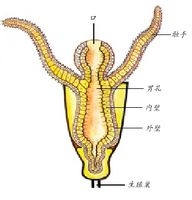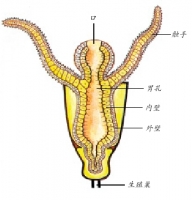|
qiāng cháng dòng wù qiāng cháng dòng wù |
 腔肠动物 qiāng cháng dòng wù 腔肠动物 qiāng cháng dòng wù |
|
 腔肠动物 腔肠动物
后生动物,是有腔肠的动物类群所成的一门。分为有刺胞类(水媳纲、钵水母纲、珊瑚纲)和无刺胞类(栉板类或栉水母类)2个亚门,前者有刺细胞,后者有粘细胞;由于后者完全不具水螅型,所以也可把两者各作为独立的门,即有刺胞动物门(cn-idaria,或狭义的腔肠动物)和有栉板动物门(ct-enaria,或栉水母门ctenophora)。一般认为成体仍保持着原肠胚的形态。身体仅由外胚层和内胚层所构成,无中胚层。内外两胚层之间充有琼质样的胶质,称为胶质层,(有人把散在其中的游走细胞看作为中胚层性的细胞)。由内胚层形成的原肠即为腔肠。内胚层细胞司消化作用进行细胞内消化。原口可成为成体的口。
第一节 腔肠动物的特征
一、辐射对称
腔肠动物的身体已有固定的形状,且辐射对称,即通过身体的中轴有许多切面将身体分成对称的两半。只有口面和反口面之分。有些种类通过中轴只有两个切面,将身体分成相等的两半,称两辐射对称,如海葵。这是介于辐射对称和两侧对称之间的一种形式。
二、两胚层及原始的消化腔
腔肠动物是具有真正的内外两胚层动物,在两胚层之间有由内外胚层细胞分泌的中胶层。体内的空腔即原肠腔,有细胞外消化的机能,残渣由口排出,所以又称为消化循环腔,或称腔肠,腔肠动物由此而得名。
三、细胞和组织分化
腔肠动物的细胞已分化为皮肌细胞、腺细胞、间细胞、刺细胞、感觉细胞等。皮肌细胞是内外胚层中的主要细胞,可执行上皮与肌肉的生理机能,故称皮肌细胞,这也表明腔肠动物开始有了原始的上皮与肌肉组织。皮肌细胞的基部延伸出一个或几个细长的突起,其中有肌原纤维分布,其成分和收缩机理与高等动物相似。
四、网状神经系统
从腔肠动物开始出现神经系统。神经细胞彼此以神经突起相联而成网状,所以称为网状神经系统。神经细胞与内外胚层中的感觉细胞、皮肌细胞相连,对外界的各种刺激产生有效的反应,但没有神经中枢。神经传导一般没有固定的方向,因此称为分散性神经系统。
腔肠动物没有呼吸与排泄器官,主要依靠细胞表面从水中获得氧气并把二氧化碳等废物直接排入水中,或者排入消化循环腔内,由口排出。
五、具水螅型,水母型两种基本形态
水螅型营固着生活,体呈圆筒状,固着端称基盘,另一端为摄食的口,周围有触手,中胶层薄。珊瑚纲的水螅型,体壁的外胚层可分泌石灰质的外骨骼。水母型营漂浮生活,体呈圆盘状,突出的一面称外伞,凹入的一面称下伞,其中央悬挂着一条垂管,管的末端是口,由口通入消化循环腔和分枝状的辐管,并一直通到伞的边缘连接环管,伞的边缘有触手和感觉器管(平衡囊、触手囊)。水螅水母由下伞边缘向中央伸展一圈薄膜,称缘膜。
六、生殖方法
有无性生殖和有性生殖两种。无性生殖常以出芽方式形成群体。有性生殖多为雌雄异体,水螅纲的生殖腺由外胚层形成,但钵水母纲和珊瑚纲的生殖腺却来自内胚层,生殖细胞由间细胞而来。海产种类在胚胎发育过程中有浮浪幼虫期。
第二节 代表动物——水螅
水螅(hydra)生活在水质洁净的池塘或小溪流中,附着在水草、落叶或水底岩石上
一、外形
水螅身体呈圆柱状,一端附着在其他物体上称为基盘,游离一端有圆锥状的突起,称垂唇,中央有口,周围有辐射状排列的触手6—12条,为捕食器官,在体侧常有水螅芽体。
二、体壁
由外胚层、内胚层和中胶层组成。
(一)外胚层 细胞排列整齐,较薄,由外皮肌细胞、间细胞,刺细胞、腺细胞、感觉细胞和神经细胞组成。外皮肌细胞呈柱状,基部有纵行排列的肌纤维。间细胞是小型未分化的细胞,分布在皮肌细胞之间,由它分化出刺细胞和生殖细胞等。刺细胞是腔肠动物特有的一种细胞,主要分布在触手上和体表。刺细胞内含有一个细胞核和一个刺丝囊,囊内有毒液及一条盘旋的刺丝管,刺细胞外侧有一刺针,当刺针受到刺激时,刺丝连同毒液立即射出,把毒液射入敌害或捕获物中,使之麻醉或杀死,这种刺丝囊称穿刺刺丝囊。水螅还有卷缠刺丝囊及两种粘性刺丝囊,这些都与运动捕食有关。刺丝射出后,刺细胞逐渐萎缩,由间细胞补充。腺细胞主要分布在基盘和口区,分泌粘液,用以附着、保护和协助取食,也可以分泌气体,帮助水螅从水底升到水面。感觉细胞分散在皮肌细胞之间,特别在口周围、触手和基盘上较多;感觉细胞小,端部具感觉毛,基部与神经纤维相连。神经细胞位于外胚层细胞的基部,接近中胶层部分,神经细胞的突起彼此连接,形成神经网。外胚层的主要机能是保护、感觉、运动和生殖等。
(二)中胶层 薄而透明,由内外胚层细胞分泌的胶状物质组成,似弹性骨骼,内有许多小纤维,皮肌细胞突起也伸到其中,起支持身体的作用。
(三)内胚层 由内皮肌细胞、腺细胞、少量感觉细胞与间细胞组成,细胞排列较外胚层厚,内皮肌细胞长而大,通常在细胞的顶端有2条鞭毛,鞭毛的摆动能激动水流,有的皮肌细胞顶端能伸出伪足,用于捕食,进行细胞内消化,因此又称营养肌肉细胞。腺细胞在皮肌细胞之间,内含许多分泌颗粒,能分泌消化酶,进行细胞外消化。间细胞、感觉细胞和神经细胞数目较少。内胚层的主要机能是营养。
三、生理
(一)摄食与消化 水螅的食物多为小型甲壳类(水蚤)、水栖寡毛类及昆虫的幼虫等。当水螅感知食物接近触手时,便立即射出刺丝,使其麻醉或杀死,再用触手送入口内,食物被吞入消化循环腔内,由腺细胞分泌消化酶进行细胞外消化,消化后的食物颗粒再由内皮肌细胞伸出伪足,进行细胞内消化。水螅有口无肛门,残渣仍经口排出。
水螅没有呼吸和排泄器官,气体交换和代谢废物的排出由细胞表面直接进行。
(二)运动 水螅营固着生活,当环境不利时,可以离开原来的固着点漂荡,运动方式为丈量式运动,或称尺蠖状爬行。还可作翻筋斗运动,运动一般趋向光线适度、氧气充足、食物丰富的地方。
(三)生殖 营无性生殖和有性生殖。无性生殖以出芽方式进行,出芽的位置一般在动物体中下部;体壁的某一部分向外凸出,形成芽体,逐渐长大,最后基部收缩与母体脱离而独立生活。水螅不形成群体,有性生殖多发生在秋冬季节来临时。雌雄同体,生殖细胞由外胚层的间细胞形成。精巢位于在近触手的一端,呈锥状。卵巢位于近基盘的一端,呈球状,卵子成熟后,卵巢破裂,卵子外露。精子成熟后并从精巢内逸出,在水中游泳,与卵子结合,行异体受精。受精卵经过多次分裂后,形成一个实心的原肠胚,并在外胚层外,分泌一层角质膜,保护胚胎。这时胚胎停止发育,并离开母体,沉入水底进入休眠期以渡过严冬。到翌年春季,环境条件较好时,厚的角质膜破裂,胚胎逸出,发育成一个新的个体。
(四)再生 水螅的再生能力很强,将水螅体任意切成数段,每一小段都可再生出所失去的部分;而形成一个新的个体。由于水螅有很强的再生能力,因而是理想的实验动物材料之一。
第三节 腔肠动物门的分类
一、水螅纲(hydrozoa)
本纲种类很多,多数生活在海水中,少数生活在淡水。生活史中有固着的水螅型和自由游泳的水母型。水螅型结构简单,只有简单的消化循环腔。水母型有缘膜,触手基部有平衡囊,生殖腺由外胚层形成,生活史中有世代交替现象。本纲约有3 700种,代表动物有:水螅、生活在珠江流域的淡水棒螅( cordylophora lacust ris)和海栖的薮枝螅( obelia geniculat a)等。
薮枝螅:分布于浅海区,以树枝状的群体固着生活。群体基部生有许多葡萄状的分枝,称螅根;螅根上生出直立向上延伸的部分,称螅茎;向两侧相互长出分枝,称螅枝。螅枝的顶端生出水螅体或生殖体。群体的周围生着一层透明的外骨骼,称围鞘,是由外胚层分泌所成。围鞘之内为共肉,由外胚层、中胶层与内胚层共同构成,中间的空腔称共肉腔。共肉是群体的共同组织,与水螅体、生殖体相连接。
水螅体上端有口和垂唇,周围生有许多实心的触手,口下接消化循环腔,与共肉腔相通。水螅体的周围有一个杯状的鞘,称水螅鞘,任何一个水螅体捕获到的食物经消化后,可通过消化循环腔输送到群体的其他部分。水螅体能进行防御、捕食、消化、吸收和排泄的机能,为营养个员。
生殖体无触手和口,中央有一柄状物称子茎,与共肉相通,子茎外面有瓶状的围鞘,称生殖鞘。子茎上的细胞以出芽生殖产生许多水母芽,成熟后经生殖鞘的开口游出,成为水母体。
水母体呈伞状,在下伞的中央伸出一条垂管,其末端有一方形的口,内通消化循环腔、4条辐管及伞边缘的环管。伞的边缘上有一圈触手,内有一个神经环与环管平行,又有8个位于触手中的平衡囊与神经环相通。水母体为雌雄异体,精、卵成熟后在海水中受精,受精卵发育成实心的原肠胚,体表生有纤毛,称为浮浪幼虫。浮浪幼虫经过一段时间的游泳生活后,就停留在一物体上,一端附着,另一端生出触手、垂唇和口,成为一个水螅体;并以出芽繁殖方式发育为群体。水母体的生活期短,产生性细胞后即死亡。
薮枝螅从无性世代产生有性世代的水母体,水母体产生精子和卵,受精后发育为无性的群体,这种现象称为世代交替。
桃花水母( craspedacusta soweroyi):生殖腺呈红色,常发生在桃花盛开的季节,水母在水中漂游,白水夹红色,酷似桃花,故称桃花水母。产于我国四川嘉陵江及长江沿岸各湖泊中,因桃花水母的盛发期正值长江天然鱼类产卵期,对鱼苗危害性很大。
桃花水母体呈圆伞形,渔民根据其体形称其为降落伞鱼。水母体直径约1—2厘米,下伞中央有一长垂管,末端为口,内通消化循环腔、4条辐管及伞边缘的环管。在每一条辐管下面由外胚层形成红色的生殖腺,雌雄异体。由伞边缘向下伞中央伸展出一圈多肌纤维的缘膜。由于肌纤维的收缩,水由缘膜孔进出,使之游泳前进。伞的边缘上有很多触手,伸缩性强,其中4条很长,有感觉作用。感觉器官为平衡囊,由位于触手基部的内胚层形成,数目较多。桃花水母的水螅型,个体很小,约3毫米,有很多分枝,上有刺细胞,无触手,由刺细胞捕捉食物,在其中的一种分枝上着生水母芽,逐渐长大,成为有性的水母,但世代交替现象不甚明显。
二、钵水母纲(scyphozoa)
或称水母纲(真水母纲)。本纲动物全部海产,水母型极发达,感觉器官为触手囊,无缘膜,水螅型退化成没有,生殖腺起源于内胚层。本纲约200种,常见者有:
海月水母(aurelia aurit a):每年的四五月至七八月成群出现在我国北方近海海面及沿岸地带。体呈扁圆的伞状,4条口腕在水中飘荡,酷似旗帜,因此又称旗口水母;同时,由于体白色半透明而呈盘状,恰似水中之月,故将海月水母之名。数多而易获得,常为实验材料。
海蜇(rhopilema esculent um):伞体高而厚,呈淡蓝色的半球形,中胶层很厚,游泳能力很强。伞的边缘无触手,有8个缺刻,内有感觉器官触手囊。海蜇幼体有中央口及4条口腕,在成长的过程中逐渐封闭了中央口,各口腕又分枝,生长成8个三翼状的口腕,边缘愈合成许多吸口,周围有许多触手,其上面有刺细胞和腺细胞,帮助捕捉食物。食物由吸口、经口腕中分支的小管到达胃腔进行消化。口腕的构造和取食方式像植物根吸收养料,因此将海蜇这类水母称为根口水母。
海蜇体内含有蛋白质、维生素及各种无机盐。海蜇的伞部可加工成海蜇皮,口腕部分加工成海蜇头,是广大人民喜爱的海味品。我国沿海有四种海蜇可供食用,如海蜇和黄斑海蜇(r.his pidum)等。海蜇也可供药用,有消炎化痰,散瘀降压的功效。海蜇大量繁殖时,会影响渔业生产。人们还发现,在台风来临之前,海蜇即已离开沿岸,游向深海,躲避强风巨浪的袭击。经研究,水母感觉器官中的平衡石能感觉出人耳听不到的次声波。人们仿照水母的感觉器官,制造出一种水中测声仪,可提前15小时测出台风来临的预兆。
三、珊瑚纲(ant hozoa)
全部海产,只有水螅型(单体或群体),没有水母型。有外胚层下陷形成的口道。口道两侧有一纤毛的口道沟,因而体呈左右辐射对称。消化循环腔中有内腔层突出的隔膜,其数目为8个、6个或6的倍数。生殖腺由内胚层形成。中胶层内有发达的结缔组织。多数种类具有石灰质的外骨骼。
海葵(actiniaria):固着在湖间带的岩石上,或穴居在沙石中。体呈长筒形,无骨骼,肌肉发达,有很多隔膜和触指,总数为6的倍数,触指充分伸展时,呈菊花状。海葵肉食性,贪食。有些种类与其他动物或单细胞藻类共生,为沿海常见动物。
本纲还有各种具外骨骼的珊瑚。珊瑚的种类很多,常见者有鹿角珊瑚(madrepora)、石芝(fungiia)等。它们的骨骼除可制成珍贵的工艺品外,骨骼与泥沙的沉积,可形成珊瑚礁,如我国的西沙、中沙、南沙群岛等。珊瑚的丛生,为鱼类提供了栖息场所,是海洋渔业理想的繁殖保护区。珊瑚骨骼的堆积,在地层中形成石灰岩,又为地质学、考古学及矿床的利用提供材料。但珊瑚常形成暗礁,为航海带来危害。
第四节 腔肠动物的系统发展
一般认为,腔肠动物起源于一个与浮浪幼虫相似的祖先。这个祖先可能是鞭毛纲的群体,根据梅氏假说,由细胞移入形成原始的两胚层动物,由它进化为水螅纲,再由水螅纲沿着不同的途径发展为钵水母纲和珊瑚纲。
腔肠动物小结
腔肠动物为体呈辐射对称或两辐对称的两胚层多细胞动物。有口无肛门,出现消化循环腔,能行细胞外消化和细胞内消化。出现原始的肌肉组织、神经组织及感觉器官。有特殊的刺细胞。有由外胚层细胞分泌的石灰质或角质骨骼。有水螅型和水母型。生殖方式有无性生殖和有性生殖两种,有的种类具世代交替现象,海产种类具有自由游泳的浮浪幼虫期。全部水生,绝大多数海产。 |
腔肠动物概述(Coelenterate ) Coelenterate Overview (Coelenterate) |
后生动物,是有腔肠的动物类群所成的一门。分为有刺胞类(水媳纲、钵水母纲、珊瑚纲)和无刺胞类(栉板类或栉水母类)2个亚门,前者有刺细胞,后者有粘细胞;由于后者完全不具水螅型,所以也可把两者各作为独立的门,即有刺胞动物门(Cn-idaria,或狭义的腔肠动物)和有栉板动物门(Ct-enaria,或栉水母门Ctenophora)。一般认为成体仍保持着原肠胚的形态。身体仅由外胚层和内胚层所构成,无中胚层。内外两胚层之间充有琼质样的胶质,称为胶质层,(有人把散在其中的游走细胞看作为中胚层性的细胞)。由内胚层形成的原肠即为腔肠。内胚层细胞司消化作用进行细胞内消化。原口可成为成体的口。
腔肠动物大约有1 万种,有几种生活在淡水中,但多数生活在海水中。这类水生动物身体中央生有空囊,因此整个动物有的呈钟形,有的呈伞形。腔肠动物的触手十分敏感,上面生有成组的被称为刺丝囊的刺细胞。如果触手碰到可以吃的东西,末端带毒的细线就会从刺丝囊中伸出,刺入猎物体内。 |
腔肠动物的特征 Characteristics of coelenterate |
一、辐射对称
腔肠动物的身体已有固定的形状,且辐射对称,即通过身体的中轴有许多切面将身体分成对称的两半。只有口面和反口面之分。有些种类通过中轴只有两个切面,将身体分成相等的两半,称两辐射对称,如海葵。这是介于辐射对称和两侧对称之间的一种形式。
二、两胚层及原始的消化腔
腔肠动物是具有真正的内外两胚层动物,在两胚层之间有由内外胚层细胞分泌的中胶层。体内的空腔即原肠腔,有细胞外消化的机能,残渣由口排出,所以又称为消化循环腔,或称腔肠,腔肠动物由此而得名。
三、细胞和组织分化
腔肠动物的细胞已分化为皮肌细胞、腺细胞、间细胞、刺细胞、感觉细胞等。皮肌细胞是内外胚层中的主要细胞,可执行上皮与肌肉的生理机能,故称皮肌细胞,这也表明腔肠动物开始有了原始的上皮与肌肉组织。皮肌细胞的基部延伸出一个或几个细长的突起,其中有肌原纤维分布,其成分和收缩机理与高等动物相似。
四、网状神经系统
从腔肠动物开始出现神经系统。神经细胞彼此以神经突起相联而成网状,所以称为网状神经系统。神经细胞与内外胚层中的感觉细胞、皮肌细胞相连,对外界的各种刺激产生有效的反应,但没有神经中枢。神经传导一般没有固定的方向,因此称为分散性神经系统。
腔肠动物没有呼吸与排泄器官,主要依靠细胞表面从水中获得氧气并把二氧化碳等废物直接排入水中,或者排入消化循环腔内,由口排出。
五、具水螅型,水母型两种基本形态
水螅型营固着生活,体呈圆筒状,固着端称基盘,另一端为摄食的口,周围有触手,中胶层薄。珊瑚纲的水螅型,体壁的外胚层可分泌石灰质的外骨骼。水母型营漂浮生活,体呈圆盘状,突出的一面称外伞,凹入的一面称下伞,其中央悬挂着一条垂管,管的末端是口,由口通入消化循环腔和分枝状的辐管,并一直通到伞的边缘连接环管,伞的边缘有触手和感觉器管(平衡囊、触手囊)。水螅水母由下伞边缘向中央伸展一圈薄膜,称缘膜。
六、生殖方法
有无性生殖和有性生殖两种。无性生殖常以出芽方式形成群体。有性生殖多为雌雄异体,水螅纲的生殖腺由外胚层形成,但钵水母纲和珊瑚纲的生殖腺却来自内胚层,生殖细胞由间细胞而来。海产种类在胚胎发育过程中有浮浪幼虫期。 |
代表动物——水螅 On behalf of animals - Hydra |
水螅(Hydra)生活在水质洁净的池塘或小溪流中,附着在水草、落叶或水底岩石上
一、外形
水螅身体呈圆柱状,一端附着在其他物体上称为基盘,游离一端有圆锥状的突起,称垂唇,中央有口,周围有辐射状排列的触手6—12条,为捕食器官,在体侧常有水螅芽体。
二、体壁
由外胚层、内胚层和中胶层组成。
(一)外胚层 细胞排列整齐,较薄,由外皮肌细胞、间细胞,刺细胞、腺细胞、感觉细胞和神经细胞组成。外皮肌细胞呈柱状,基部有纵行排列的肌纤维。间细胞是小型未分化的细胞,分布在皮肌细胞之间,由它分化出刺细胞和生殖细胞等。刺细胞是腔肠动物特有的一种细胞,主要分布在触手上和体表。刺细胞内含有一个细胞核和一个刺丝囊,囊内有毒液及一条盘旋的刺丝管,刺细胞外侧有一刺针,当刺针受到刺激时,刺丝连同毒液立即射出,把毒液射入敌害或捕获物中,使之麻醉或杀死,这种刺丝囊称穿刺刺丝囊。水螅还有卷缠刺丝囊及两种粘性刺丝囊,这些都与运动捕食有关。刺丝射出后,刺细胞逐渐萎缩,由间细胞补充。腺细胞主要分布在基盘和口区,分泌粘液,用以附着、保护和协助取食,也可以分泌气体,帮助水螅从水底升到水面。感觉细胞分散在皮肌细胞之间,特别在口周围、触手和基盘上较多;感觉细胞小,端部具感觉毛,基部与神经纤维相连。神经细胞位于外胚层细胞的基部,接近中胶层部分,神经细胞的突起彼此连接,形成神经网。外胚层的主要机能是保护、感觉、运动和生殖等。
(二)中胶层 薄而透明,由内外胚层细胞分泌的胶状物质组成,似弹性骨骼,内有许多小纤维,皮肌细胞突起也伸到其中,起支持身体的作用。
(三)内胚层 由内皮肌细胞、腺细胞、少量感觉细胞与间细胞组成,细胞排列较外胚层厚,内皮肌细胞长而大,通常在细胞的顶端有2条鞭毛,鞭毛的摆动能激动水流,有的皮肌细胞顶端能伸出伪足,用于捕食,进行细胞内消化,因此又称营养肌肉细胞。腺细胞在皮肌细胞之间,内含许多分泌颗粒,能分泌消化酶,进行细胞外消化。间细胞、感觉细胞和神经细胞数目较少。内胚层的主要机能是营养。 |
|
(一)摄食与消化 水螅的食物多为小型甲壳类(水蚤)、水栖寡毛类及昆虫的幼虫等。当水螅感知食物接近触手时,便立即射出刺丝,使其麻醉或杀死,再用触手送入口内,食物被吞入消化循环腔内,由腺细胞分泌消化酶进行细胞外消化,消化后的食物颗粒再由内皮肌细胞伸出伪足,进行细胞内消化。水螅有口无肛门,残渣仍经口排出。
水螅没有呼吸和排泄器官,气体交换和代谢废物的排出由细胞表面直接进行。
(二)运动 水螅营固着生活,当环境不利时,可以离开原来的固着点漂荡,运动方式为丈量式运动,或称尺蠖状爬行。还可作翻筋斗运动,运动一般趋向光线适度、氧气充足、食物丰富的地方。
(三)生殖 营无性生殖和有性生殖。无性生殖以出芽方式进行,出芽的位置一般在动物体中下部;体壁的某一部分向外凸出,形成芽体,逐渐长大,最后基部收缩与母体脱离而独立生活。水螅不形成群体,有性生殖多发生在秋冬季节来临时。雌雄同体,生殖细胞由外胚层的间细胞形成。精巢位于在近触手的一端,呈锥状。卵巢位于近基盘的一端,呈球状,卵子成熟后,卵巢破裂,卵子外露。精子成熟后并从精巢内逸出,在水中游泳,与卵子结合,行异体受精。受精卵经过多次分裂后,形成一个实心的原肠胚,并在外胚层外,分泌一层角质膜,保护胚胎。这时胚胎停止发育,并离开母体,沉入水底进入休眠期以渡过严冬。到翌年春季,环境条件较好时,厚的角质膜破裂,胚胎逸出,发育成一个新的个体。
(四)再生 水螅的再生能力很强,将水螅体任意切成数段,每一小段都可再生出所失去的部分;而形成一个新的个体。由于水螅有很强的再生能力,因而是理想的实验动物材料之一。
第三节 腔肠动物门的分类
一、水螅纲(Hydrozoa)
本纲种类很多,多数生活在海水中,少数生活在淡水。生活史中有固着的水螅型和自由游泳的水母型。水螅型结构简单,只有简单的消化循环腔。水母型有缘膜,触手基部有平衡囊,生殖腺由外胚层形成,生活史中有世代交替现象。本纲约有3 700种,代表动物有:水螅、生活在珠江流域的淡水棒螅( Cordylophora lacust ris)和海栖的薮枝螅( Obelia geniculat a)等。
薮枝螅:分布于浅海区,以树枝状的群体固着生活。群体基部生有许多葡萄状的分枝,称螅根;螅根上生出直立向上延伸的部分,称螅茎;向两侧相互长出分枝,称螅枝。螅枝的顶端生出水螅体或生殖体。群体的周围生着一层透明的外骨骼,称围鞘,是由外胚层分泌所成。围鞘之内为共肉,由外胚层、中胶层与内胚层共同构成,中间的空腔称共肉腔。共肉是群体的共同组织,与水螅体、生殖体相连接。
水螅体上端有口和垂唇,周围生有许多实心的触手,口下接消化循环腔,与共肉腔相通。水螅体的周围有一个杯状的鞘,称水螅鞘,任何一个水螅体捕获到的食物经消化后,可通过消化循环腔输送到群体的其他部分。水螅体能进行防御、捕食、消化、吸收和排泄的机能,为营养个员。
生殖体无触手和口,中央有一柄状物称子茎,与共肉相通,子茎外面有瓶状的围鞘,称生殖鞘。子茎上的细胞以出芽生殖产生许多水母芽,成熟后经生殖鞘的开口游出,成为水母体。
水母体呈伞状,在下伞的中央伸出一条垂管,其末端有一方形的口,内通消化循环腔、4条辐管及伞边缘的环管。伞的边缘上有一圈触手,内有一个神经环与环管平行,又有8个位于触手中的平衡囊与神经环相通。水母体为雌雄异体,精、卵成熟后在海水中受精,受精卵发育成实心的原肠胚,体表生有纤毛,称为浮浪幼虫。浮浪幼虫经过一段时间的游泳生活后,就停留在一物体上,一端附着,另一端生出触手、垂唇和口,成为一个水螅体;并以出芽繁殖方式发育为群体。水母体的生活期短,产生性细胞后即死亡。
薮枝螅从无性世代产生有性世代的水母体,水母体产生精子和卵,受精后发育为无性的群体,这种现象称为世代交替。
桃花水母( Craspedacusta soweroyi):生殖腺呈红色,常发生在桃花盛开的季节,水母在水中漂游,白水夹红色,酷似桃花,故称桃花水母。产于我国四川嘉陵江及长江沿岸各湖泊中,因桃花水母的盛发期正值长江天然鱼类产卵期,对鱼苗危害性很大。
桃花水母体呈圆伞形,渔民根据其体形称其为降落伞鱼。水母体直径约1—2厘米,下伞中央有一长垂管,末端为口,内通消化循环腔、4条辐管及伞边缘的环管。在每一条辐管下面由外胚层形成红色的生殖腺,雌雄异体。由伞边缘向下伞中央伸展出一圈多肌纤维的缘膜。由于肌纤维的收缩,水由缘膜孔进出,使之游泳前进。伞的边缘上有很多触手,伸缩性强,其中4条很长,有感觉作用。感觉器官为平衡囊,由位于触手基部的内胚层形成,数目较多。桃花水母的水螅型,个体很小,约3毫米,有很多分枝,上有刺细胞,无触手,由刺细胞捕捉食物,在其中的一种分枝上着生水母芽,逐渐长大,成为有性的水母,但世代交替现象不甚明显。 |
钵水母纲(Scyphozoa) Scyphozoa (Scyphozoa) |
或称水母纲(真水母纲)。本纲动物全部海产,水母型极发达,感觉器官为触手囊,无缘膜,水螅型退化成没有,生殖腺起源于内胚层。本纲约200种,常见者有:
海月水母(Aurelia aurit a):每年的四五月至七八月成群出现在我国北方近海海面及沿岸地带。体呈扁圆的伞状,4条口腕在水中飘荡,酷似旗帜,因此又称旗口水母;同时,由于体白色半透明而呈盘状,恰似水中之月,故将海月水母之名。数多而易获得,常为实验材料。
海蜇(Rhopilema esculent um):伞体高而厚,呈淡蓝色的半球形,中胶层很厚,游泳能力很强。伞的边缘无触手,有8个缺刻,内有感觉器官触手囊。海蜇幼体有中央口及4条口腕,在成长的过程中逐渐封闭了中央口,各口腕又分枝,生长成8个三翼状的口腕,边缘愈合成许多吸口,周围有许多触手,其上面有刺细胞和腺细胞,帮助捕捉食物。食物由吸口、经口腕中分支的小管到达胃腔进行消化。口腕的构造和取食方式像植物根吸收养料,因此将海蜇这类水母称为根口水母。
海蜇体内含有蛋白质、维生素及各种无机盐。海蜇的伞部可加工成海蜇皮,口腕部分加工成海蜇头,是广大人民喜爱的海味品。我国沿海有四种海蜇可供食用,如海蜇和黄斑海蜇(R.his pidum)等。海蜇也可供药用,有消炎化痰,散瘀降压的功效。海蜇大量繁殖时,会影响渔业生产。人们还发现,在台风来临之前,海蜇即已离开沿岸,游向深海,躲避强风巨浪的袭击。经研究,水母感觉器官中的平衡石能感觉出人耳听不到的次声波。人们仿照水母的感觉器官,制造出一种水中测声仪,可提前15小时测出台风来临的预兆。 |
珊瑚纲(Ant hozoa) Coral Programme (Ant hozoa) |
全部海产,只有水螅型(单体或群体),没有水母型。有外胚层下陷形成的口道。口道两侧有一纤毛的口道沟,因而体呈左右辐射对称。消化循环腔中有内腔层突出的隔膜,其数目为8个、6个或6的倍数。生殖腺由内胚层形成。中胶层内有发达的结缔组织。多数种类具有石灰质的外骨骼。
海葵(Actiniaria):固着在湖间带的岩石上,或穴居在沙石中。体呈长筒形,无骨骼,肌肉发达,有很多隔膜和触指,总数为6的倍数,触指充分伸展时,呈菊花状。海葵肉食性,贪食。有些种类与其他动物或单细胞藻类共生,为沿海常见动物。
本纲还有各种具外骨骼的珊瑚。珊瑚的种类很多,常见者有鹿角珊瑚(Madrepora)、石芝(Fungiia)等。它们的骨骼除可制成珍贵的工艺品外,骨骼与泥沙的沉积,可形成珊瑚礁,如我国的西沙、中沙、南沙群岛等。珊瑚的丛生,为鱼类提供了栖息场所,是海洋渔业理想的繁殖保护区。珊瑚骨骼的堆积,在地层中形成石灰岩,又为地质学、考古学及矿床的利用提供材料。但珊瑚常形成暗礁,为航海带来危害。 |
腔肠动物的系统发展 Coelenterate systems development |
一般认为,腔肠动物起源于一个与浮浪幼虫相似的祖先。这个祖先可能是鞭毛纲的群体,根据梅氏假说,由细胞移入形成原始的两胚层动物,由它进化为水螅纲,再由水螅纲沿着不同的途径发展为钵水母纲和珊瑚纲。
腔肠动物小结
腔肠动物为体呈辐射对称或两辐对称的两胚层多细胞动物。有口无肛门,出现消化循环腔,能行细胞外消化和细胞内消化。出现原始的肌肉组织、神经组织及感觉器官。有特殊的刺细胞。有由外胚层细胞分泌的石灰质或角质骨骼。有水螅型和水母型。生殖方式有无性生殖和有性生殖两种,有的种类具世代交替现象,海产种类具有自由游泳的浮浪幼虫期。全部水生,绝大多数海产。 |
|
- : coelenterata
- n.: coelenterate
|
|
| 生物 | 动物 | 水螅属 | 螅形目 | 动物学 | 生物学 | 水母 | 科学 | | 海洋生物 | 环保科普 | 无脊椎动物 | 水生物 | 古生物学 | 水螅虫纲 | 自然 | 珊瑚虫纲 | | 古生物 | 海洋动物 | 水螅纲 | 海洋 | 自然科学 | 更多结果... |
|
|
| 腔肠动物门 | 腔肠动物的 | 腔肠动物纲 | | 腔肠动物的腔肠体 | 腔肠动物与人类的关系 | 腔肠动物的系统发生 | | 腔肠动物的主要分纲 | 腔肠动物门的主要的特征 | |
|